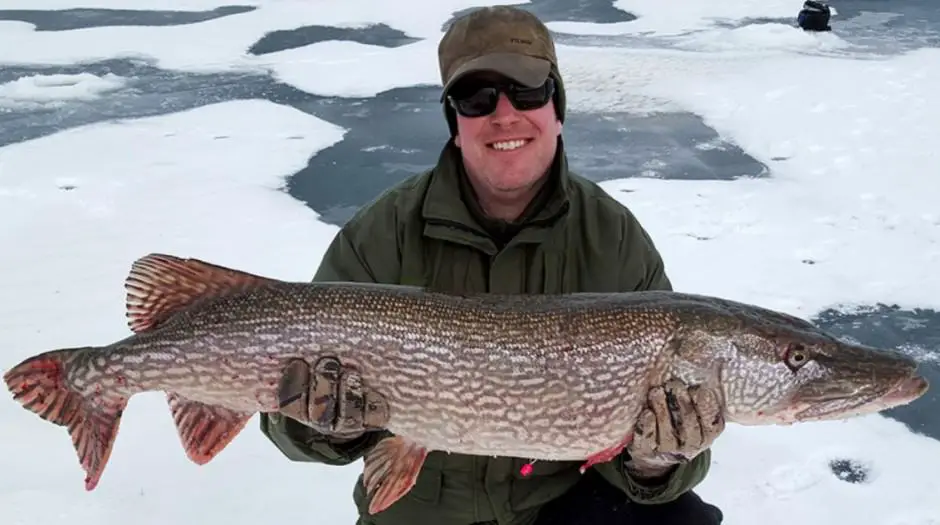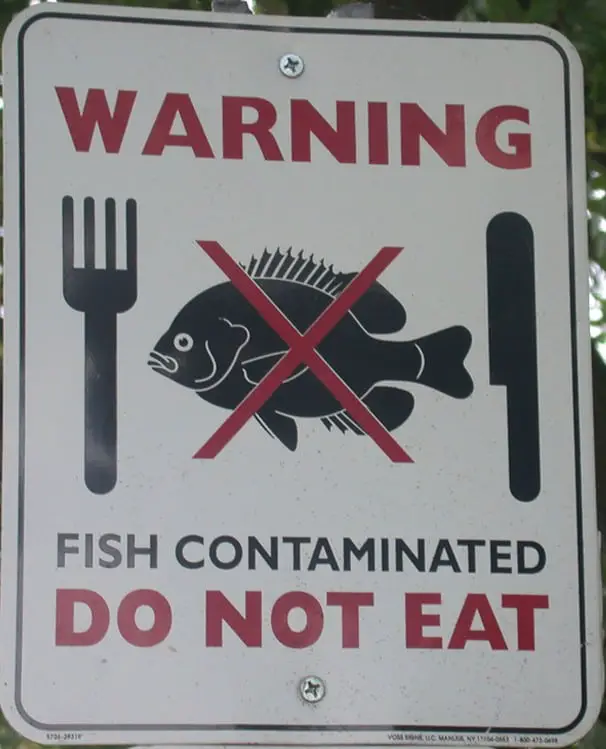I’ve made no secret of the fact that I’m a huge fan of the taste of northern pike. I haven’t actually eaten musky in person, but from the few friends or friends’ fathers who have I’ve heard good things.
But a common question comes up: is pike safe to eat? This concern comes from being worried about mercury levels in the water.

This is a legitimate concern as high levels of mercury can cause severe health problems in people. And larger predatory fish tend to have the highest levels of mercury in their bodies. So is pike too dangerous to eat? Is it safe and the worries are overblown?
The truth is that northern pike in most areas are perfectly safe to eat, not having nearly the mercury concentration as big ocean fish. Although stomach meat should be avoided as it will have the highest concentration of mercury (and is generally inferior meat).
Pike from heavily polluted areas are an exception to this “generally safe” rule.
While this is coming from years of experience, if you’re like me you want to see the studies, see the evidence, see the science. Fair enough.
The rest of the article does the deep dive into what studies have found, what small precautions you can take to keep yourself safer, and simplifies the really complex science so you will understand the “Does pike contain mercury” question inside and out.
And know exactly how safe eating a pike in your area is.
Necessary Legal Disclaimer: I’m not a doctor, not a DNR specialist, not a wildlife biologist. So this article is for informational purposes and based on the best, most reliable, and most up to date information I could find available to the public.

Mercury in Pike Studies
While the full body of studies aren’t widely available, or are only available behind paywalls for academic studies/journals, there is still some really good information out there when it comes to
The Canadian Journal of Fisheries & Aquatic Sciences
An interesting study that focused on seeing how mercury levels were related in lakes in Ontario. Studies were done in lakes with only walleye, lakes with only pike, and lakes that contained both.
The results were really interesting and while over-simplified, come down to this: the mercury concentration was the same in the two species of fish based on length.
“The length-standardized mercury concentrations in coexisting walleye and northern pike in the 79 lakes were highly correlated (r2=0.60).”
From the abstract of this study done by the Canadian Journal of Fisheries & Aquatic Sciences
So pike that were 20 inches long didn’t have more mercury than a walleye that was 20 inches long.
So the fact that there isn’t a concern with mercury in walleye tells you that there shouldn’t be a ton of concern with smaller to mid-sized pike.
Now for larger pike? The larger the size by length means that a very large pike could actually have issues that you wouldn’t see in smaller fish.
Wisconsin DNR Healthy Fish Eating Guide
This is an interesting study because it is hyper focused, so keep in mind that what’s true for pike here is VERY situational in the state due to human influence in these geographic locations.
There are above average mercury deposits in water in multiple northern sections of Wisconsin, which tend to be many of the bodies of water where pike thrive in that state.
The entire guide is pretty interesting and really in-depth and well written (you should check it out if you live, or plan on fishing in, Wisconsin) it breaks down everyone into two groups:
- Women under 50 (aka of child-bearing age) and all children under 15
- Women over 50 and all men
Northern pike are a maximum of once a month recommendation for the first group, while the second group can eat one a week.
This is because of how various genders and body types react to actual mercury.
When it comes to the pike’s cousin, the musky (tiger musky should be included in this group) muskie are put as a “never eat” for group one and a “once a month” max for the second group.
Interesting Note: This seems to show that at least in Wisconsin there’s at least anecdotal evidence that musky hold more mercury or other pollutants in their flesh than northern pike do.
Canada Northwest Territories Environmental Health Sheet
The summary from this Canadian government body shows that overall the northern pike (it delights me to see a northern pike called jackfish – you don’t see that term much anymore) is a healthy part of the normal diet.
Pike, as with any fish, have the same standard recommendations when it comes to limits on consumptions for individuals. The only time a comment is made on when this might not be the case is when the pike comes from an area where there’s a warning on consuming ALL fish found in that particular place.
Vermont Fish Mercury Level Advisory
This is one that bucks the trend in multiple ways. While northern pike isn’t the lowest (not surprising since they are a predatory fish that tends to live long and grow large), but if you thought pike has a high mercury risk – you’d better re-read your sources when fishing in Vermont!
Northern pike are comparable to yellow perch and largemouth bass in the state, while they had a much lower mercury level or mercury rating than smallmouth bass, lake trout, chain pickerel, and then walleye.
If anything this shows you not to eat walleye in Vermont.
But there’s nothing “special” about the levels of mercury in pike according to this state study.
What Do Modern Experts Think?
At this point it is pretty widespread knowledge that eating fish or meat heavy in mercury is going to be bad for you. But there are some variables that change how you measure the risk vs. reward.
Here are some things that you may want to take into consideration when deciding whether it is safe to eat northern pike from a particular area or not.
Size Matters
The bigger the fish, the more it eats, the longer it has lived in those waters, and that combination means the more mercury it is likely to have in its system.
So if you are planning on eating that 30+ lb northern pike as opposed to catch and release or having the taxidermist mounting it on the wall, you might want to reconsider.
At the very least, take the tips in this article and avoid the fatty meat around the belly area to minimize any chance of exposure.
Avoid Belly Meat
This has long been good advice not only with anglers who have fished for pike for a long time, but also cooks who always found the fattiest meat around the stomach to be “Meh” in taste and flavor while the rest of the pike was delicious.
So the reason for many was simply taste and texture preference. However, when there is mercury in the water the largest predatory fish tend to store most of it in the fattiest part of their body.
In the pike this is the area around the stomach. So whether because of taste or safety, it’s a good practice just to avoid the belly meat period with pike, as the expert anglers over at Travel North Ontario point out.
Location Matters a Lot
You may notice that studies done in Canada tend to see pike as overall being much more positive than those in Wisconsin. There are a variety reasons for this but it points to a very important point in the “Is it safe to eat northern pike?” question.
Location matters. A lot. Have local waters been mildly polluted in the past? Heavily polluted? Are the waters relatively untouched from industrial toxins or are you in an area with a long history of factories during less regulated times?
This all matters. Location is a huge factor when it comes to how safe a pike is to eat.
Women Vs. Men
In general, women need to be a bit more cautious when eating fish of any kind as opposed to men. This is because mercury and pollutants that react more to their body than to men’s.
This is especially true of women of child-bearing age. Won’t deep dive the science but basically they are more susceptible to certain pollutants like mercury, meaning the amount of fish or mercury that they can safely eat is less.
In many cases the numbers are published to be on the super safe side, as they should be, but as the Wisconsin numbers show, this is a factor that does need to be taken into consideration.
Final Verdict: So Is Pike Safe to Eat?
Generally speaking, pike is safe to eat in the majority of places. Eating fish 100% of the time is a bad idea anywhere because there are pollutants in water. If you’re in a more polluted area, eat less. If you have pristine waters (by scientific chemical analysis, not by appearance) then maybe you can eat more.
Women, especially pregnant women, should always be cautious around eating all fish. However, in the majority of places northern pike doesn’t seem any different than fish of similar size in the same area.
Do a bit of research to see if there are local issues or recommendations (see the great job by Wisconsin to educate the local public) otherwise avoid the stomach meat and enjoy what this great fish has to offer!
